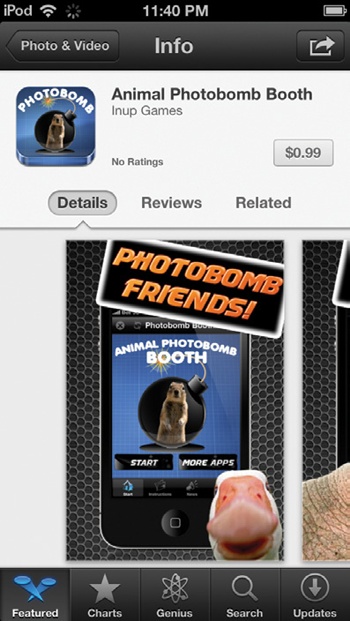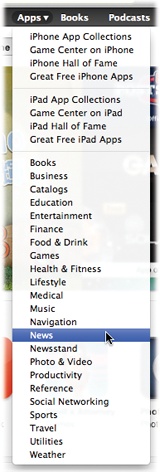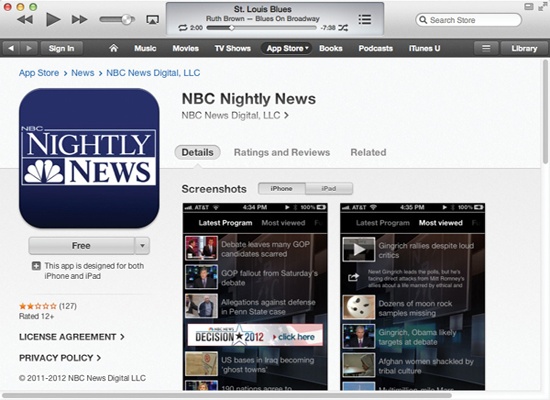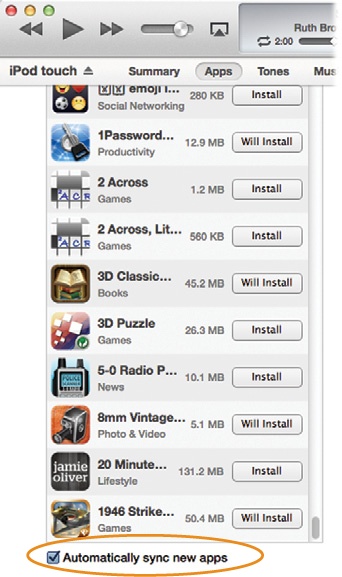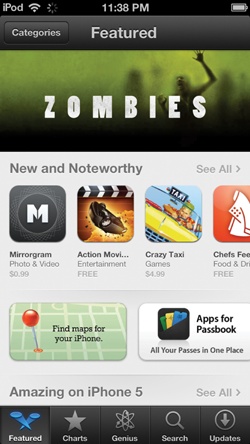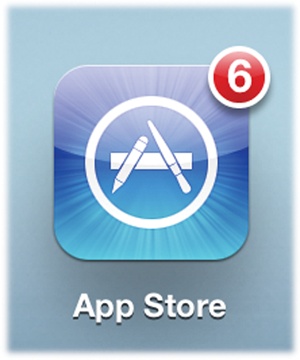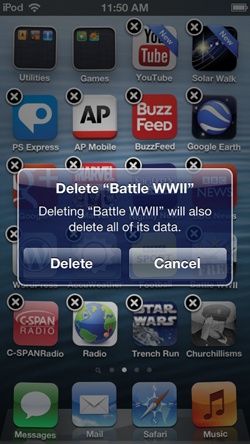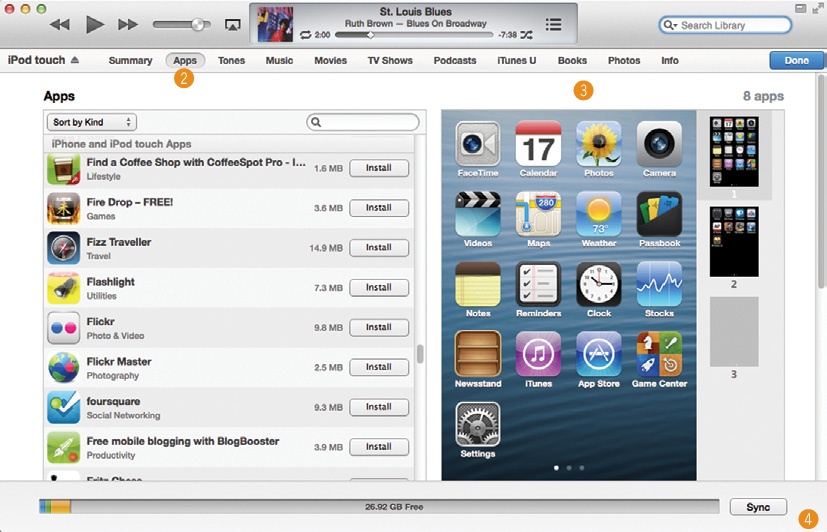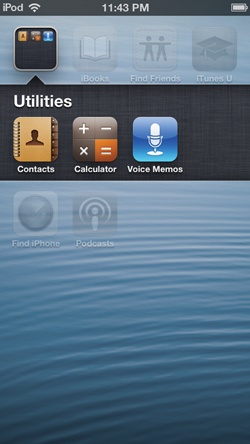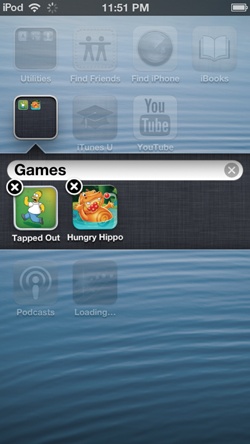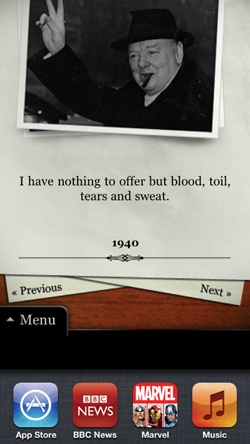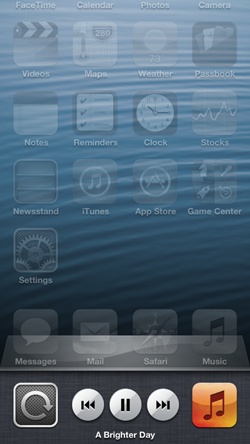Chapter 6. Add More Apps to the Touch
You’ll learn to:
Find and download new apps for your Touch
Arrange and organize apps
Keep your mini-programs up-to-date
Delete unwanted apps
Switch between apps
AS THE PAST THREE chapters have shown, the iPod Touch comes preloaded with colorful little programs that let you do a lot of stuff, like email, Web surfing, and personal-organization tasks. But you’re not limited to the Touch’s standard-issue software—thanks to the iTunes App Store, you can turn your Touch into a personalized pocket computer with its own games, productivity programs, ebooks, and more.
That’s what this chapter is about: finding new programs in the App Store that expand the powers of your Touch beyond what it comes with out of the box. Here, you’ll learn how to shop the App Store from iTunes on your computer and on the Touch itself.
Having a ton of apps turns your Touch into the electronic equivalent of a Swiss Army knife with a tool for every occasion, but having those apps strewn all over the home screen can make your iPod look like a miniature episode of Hoarders. In this chapter, you’ll learn how to organize your apps into logical order, or even stash them in a series of tidy folders for fast and easy access. Because, after all, what’s the point of buying that app if you can’t find it when you need it?
Buy iPod Touch Apps
THE APP STORE HOSTS more than 700,000 little programs you can add to your iPod Touch to make it a tiny pocket computer as well as a stylish media machine. Currency converters, 3-D video games, newsreaders, ebooks, blogging tools, guitar-chord programs, and mobile versions of popular sites like Buzzfeed and eBay are among the many offerings.
Buy Apps in iTunes
Click the App Store link on iTunes’ main Store window to see program categories like Sports and Finance. From this menu (shown at right), you can jump to any category and browse away for that video editor or sports-score app you’ve decided to add to your Touch arsenal. Many apps are free (each category’s page has a list of freebies), and most for-pay programs cost less than $10.
When you see an app you simply must have in iTunes, click the price tag or Free button under the app’s icon to start the purchase process. The bill goes to the credit card linked to your Apple ID (Set Up an Apple Account).
After you download your new app, you can sync it over to the Touch through iTunes:
If you turned on the “Automatically sync new apps” checkbox in iTunes (circled right), the media manager copies all your new purchases to the Touch the next time you sync up.
Buy Apps on the Touch
When you’ve got a WiFi connection, you can browse and buy new apps directly on the Touch. Start by tapping the blue App Store icon on the Home screen.
At the top of the Featured screen, you can see what’s new and hot. In the top-left corner, tap the Categories button to see apps grouped by category, like Finance or Games.
Tap an app to find out more about it. The Charts button (![]() ) at the bottom of the screen displays the most popular paid, free, and top-grossing apps. As with music, browsing the charts gives you an idea of what everybody else is buying or downloading. Tap the Genius icon (
) at the bottom of the screen displays the most popular paid, free, and top-grossing apps. As with music, browsing the charts gives you an idea of what everybody else is buying or downloading. Tap the Genius icon (![]() ) to have Apple suggest new apps for your collection based on apps you already bought. A Search icon (
) to have Apple suggest new apps for your collection based on apps you already bought. A Search icon (![]() ) awaits if you’re looking for something specific. The Updates button (
) awaits if you’re looking for something specific. The Updates button (![]() ) alerts you to a new version of an app you’ve previously purchased; the next page has more on that.
) alerts you to a new version of an app you’ve previously purchased; the next page has more on that.
When you find an app you want, tap the price icon, which turns into a Buy button. Hit that, type in your iTunes Store name and password (even if you’re getting a free application), and the download begins. After the program finishes loading and installing, tap its icon to launch it.
Update Apps
SEE A RED, CIRCLED number on the App Store icon on your Home screen? You’ve got updates waiting for that number of apps. As mentioned on the previous page, the same number also shows up on the Updates icon when you’re in the App Store itself.
From the iPod’s Home screen, tap the App Store icon to pop into the e-boutique. On the Updates screen, you’ll see the list of apps that need refreshing—there may be a new version of the app, for example, or bug fixes. Tap the Update button next to an app to download and install the new version. If you have a bunch of apps on the list, tap the Update All button at the top of the screen to upgrade them all at once.
Although earlier versions of the App Store required you to type in your Apple ID each time you updated an app (to prove you bought it), the App Store in iOS 6 assumes you’re updating your own apps and doesn’t pester you for the info.
Uninstall Apps
IT’S A FACT OF life: Sometimes apps don’t work out. They’re not what you thought, they’re buggy (it happens), or they take up too much precious Touch space. Here are two ways to uninstall an app:
Remove apps in iTunes. Connect the Touch to your computer, click its icon in iTunes, and then click the Applications tab. In the list of apps, deselect the ones you want to remove, and then click Sync to uninstall them from the Touch.
Remove apps on the Touch. As shown here on the Home screen, press and hold the unwanted application’s icon until it starts wiggling, and an
 appears in the corner. Tap the
appears in the corner. Tap the  , confirm your intention to delete the app, and wave goodbye to it. Press the Home button to return to business as usual.
, confirm your intention to delete the app, and wave goodbye to it. Press the Home button to return to business as usual.
Remember, even if you uninstall an app by syncing it off through iTunes or deleting it directly from the Touch, you can always download and install it again from the Purchased list in the App Store; tap the Updates button to see it.
Manage Apps in iTunes
AFTER YOU GO ON a few shopping sprees through the App Store, you may have a ton of groovy new app icons all over your Touch—but not in the order you want them. Sure, you can drag wiggling icons all over the 11 pages of your Home screen (The Home Button and Home Screen), but that can get a little confusing and frustrating if you accidentally drop an icon on the wrong page.
Fortunately, iTunes lets you arrange your Touch icons from the comfort of your big-screen computer:
Connect the iPod to your computer. Click its icon in the window.
Click the Apps tab. You now see all your applications—plus giant versions of each page of your Touch Home screen, all lined up vertically on the right side.
Select the icons you want to move. Once you click an icon on the large screen, drag it to the desired page thumbnail along the right side of the screen. It’s much easier to group similar apps on a page this way—you can have, say, a page of games or a page of video and photography apps. You can even change the four permanent icons in the gray bar at the bottom of the Touch’s screen.
Click Apply or Sync. Wait just a moment as iTunes rearranges the icons on your Touch, so they mirror how you have them in iTunes.
Organize Apps in Folders
AS MENTIONED EARLIER IN this book, you can have up to 11 Home-screen pages on your Touch and flick across them to find the apps you want. But some app-loving folk can quickly fill up all 11 screens with icons. Also, some people would prefer a tidier way to group their apps than dragging them around to different pages.
That’s where Home screen folders can make everything better. You can have up to 12 apps in a single folder—which looks like an icon with little icons nestled inside it (right). Putting apps in folders saves screen space and keeps them corralled. By default, most new Touches come with one folder from the start: the Utilities folder, which contains the Contacts, Calculator, and Voice Memos apps.
To create a folder, press and hold an icon until it wiggles, and then drag that icon on top of another one that you want in that folder as well. When you do, you automatically create a folder with a generic name on it, like “Games” (bottom-right). You can keep this name or replace it with one of your own. Once you set up a folder, you can drag up to 10 more apps into it to fill it up. Tap the screen to close the folder.
To launch an app inside a folder, tap the folder to open it, and then tap the app you want to use.
If you change your mind and want to pull an app out of a folder, open the folder and press and hold the app’s icon to start the Wiggle Dance. Now you can drag it out of the folder and back to its place on the Home screen proper.
To get rid of a folder altogether, press an icon to get them all wiggling. Drag all the apps out of the folder and back to the Home screen. When the last app is out, the folder disappears.
Multitask on Your Touch
PUTTING APPS IN FOLDERS helps you organize your Touch screen more precisely, but it doesn’t save you a lot of time when you’re in the middle of one thing and want to switch over to use another app real quickly—like when you’re reading email and want to nip out and turn on your Pandora radio app to hear some tunes as you work. Who wants to go all the way out to the Home screen for that?
Fortunately, the Touch has a shortcut. When you’re in an app, click the Home button twice. A row of four icons sprouts from the bottom of the screen, shoving the app you’re currently using up to the top of the screen (top right).
These four icons represent apps you’ve recently used. Tap one to quickly switch to it. Turn on Pandora, check your sports scores, do whatever it is you wanted to do. When you finish, double-click the Home button again. When the row of icons appears again, tap the icon of the app you were previously using to return to it.
If the app you want isn’t in this initial row of four, flick the icons from right to left until you find the one you want.
To kill apps in the hidden row that you haven’t used in forever (because they may be hogging memory), press down on an icon until the ![]() symbol appears. Tap it to remove the app from the recently used list—but not from the Touch itself. Press the Home button when you’re done.
symbol appears. Tap it to remove the app from the recently used list—but not from the Touch itself. Press the Home button when you’re done.
In addition to your most recently used apps list, the Home button double-click offers another time-saver. Instead of flicking right to left to see recent apps, flick left to right to get to the music playback controls (bottom right). They can save you the trouble of going all the way back to the Now Playing screen to skip a playlist track. And if you get agitated when the Touch reorients itself into landscape view when you try to read an ebook in bed, tap the first icon, the circular arrow in the left corner. This locks the Touch into portrait mode no matter which way you hold it—until you tap this icon again to unlock the screen.

